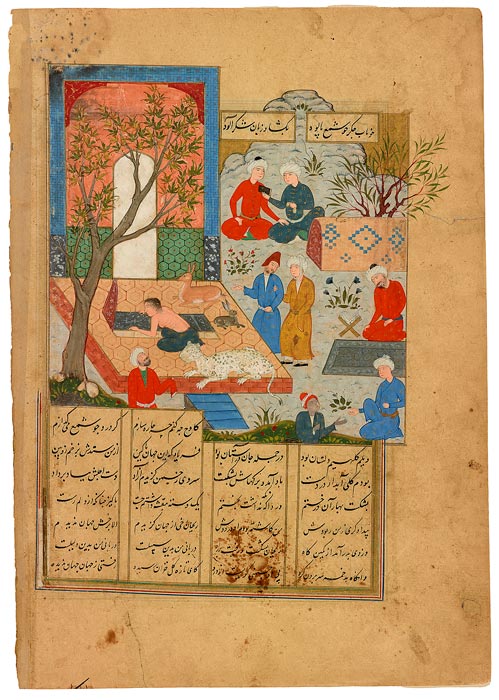
Lailā knew that Majnūn would come to mourn her, and had asked her mother to tell him that she had always remained true, and that she should be buried in bridal clothes. Majnūn comes repeatedly to mourn, watched over by his animals. On his last visit, he embraces the gravestone with both hands, and when he utters the words You, my love... , his soul leaves his body. The animals remain until nothing is left but his bones. Members of both tribes weep, and Majnūn is buried at Lailā's side. Some see Majnūn's love for Lailā as a metaphor for his all-consuming love of God.
Faithful in separation, true in love,
One tent will hold them in the world above.
Lailā va Majnūn (1188), a Persian Romeo and Juliet, is the third poem of the Khamsa (Quintet), a multi-part work by the poet Niẓāmī. The story is based on two real-life seventh-century lovers.
Persian poetry
The Persians loved their poetry and their poets, though the Qur˒an warned against believing their words (sura 69.41) and "those straying in evil who follow them" (sura 26.224). While Arabic was the first language of Islam and the language of the Qur˒an, Persian was favored by poets. Even Firdausī's (940–1020) celebrated Shāhnāma (Book of Kings), the national epic of Persian, was written in verse—some 50,000 couplets! Rūmī (1207–1273), the best known of the Sufi poets, put poetry in perspective when he wrote, "A hundred thousand books of poetry existed / Before the word of the illiterate [Prophet] they were put to shame!" (Masnavī I, 529). Presented here are illustrations of Firdausī's Shāhnāma as well as works by Sa˓ dī (ca.1184–1292), Hāfiz (ca. 1320–1389), and Jāmī (1414–1492), regarded as the last of the great Sufi poets. Also featured are illustrations from each of the five poems of the Khamsa (Quintet), by Niẓāmī (ca. 1141–1209), especially Lailā and Majnūn (The Persian Romeo and Juliet) and Bahrām Gūr's Seven Princesses.
